
In Hinduism, Shakambhari is an incarnation of Goddess Parvati. She is the divine mother, called "The Bearer of the Greens". It is said that in times of famine, the Goddess Parvati comes down as Shakambhari and gives vegan food to the hungry. Shakambhari Devi is a wonderful form of Mother Adishakti Maa Parvati. They are also depicted as having octagonal arms on four sides and elsewhere. Mother is Bhuvaneshwari Parvati, the Adhishwari of the entire geosphere. This mother is called Vaishno, Chamunda, Kangra Wali, Jwala, Chintapurni, Kamakhya, Chandi, Bala Sundari, Mansa, Naina and Shatakshi. Maa Shakambhari is Raktadantika, Chinnamastika, Bhima, Bhramari and Sri Durga. There are many Siddha Peethas in the country of Mother Shri Shakambhari. In which Sakraypeeth and Sambhar Peeth are in Rajasthan and Saharanpur Peeth is in Uttar Pradesh.
Vindhyachalpronunciation (help·info) is a city in Mirzapur District of the Indian state of Uttar Pradesh. The city is a Hindu pilgrimage site having the temple of Vindhyavasini, who according to Markandeya Purana had incarnated to kill the demon Mahishasura. The detailed description has been given in 'Durga Saptashati' Chapter of Markandeya Purana. The river Ganga flows through this city. The Indian Standard Time (IST) line passes through the Vindhyachal railway station.

Beri is a town and a Municipal committee in the Jhajjar district in northern Indian state of Haryana. The City is located 60 kilometres (37 mi) northwest of Delhi and is a trading center. Beri is one of the largest tehsils of Haryana State including 77 villages. Beri City is situated on Road Connecting Gurgaon to Hisar and Kosli (Rewari) to Rohtak. This is the middle of these four cities. The First Chief Minister of Haryana, Bhagwat Dayal Sharma, was from Beri village. The Town has a world famous temple dedicated to the goddess Mata Bhimeshwari Devi and Lord Krishna.The "Beri Pashu Mela" or "Beri Cattle Fair" is celebrated in the days of Navratra every 6 months and is famous for its donkeys and horses.
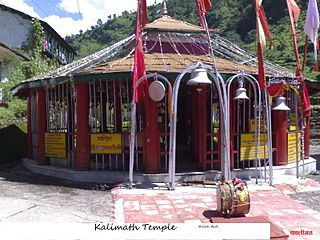
Kalimath is a village in Rudraprayag District of the Indian state of Uttarakhand. It is regarded as a divine place and shakti peeth.
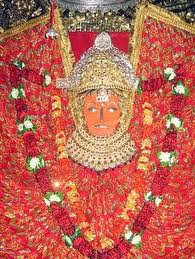
Jeenmata is a village in Sikar district of Rajasthan, India. It is located at a distance of 29 km from Sikar town in south. There is an ancient Temple dedicated to Shree Jeen Mataji(Goddess of Power). Millions of devotees assemble here for a colourful festival held twice in a year in the month of Chaitra and Ashvin during the Navratri. There are a number of dharamshalas to accommodate large number of visitors.

Santoshi Mata or Santoshi Maa is a goddess in the Hindu folklore. She is venerated as "the Mother of Satisfaction", the meaning of her name. Santoshi Mata is particularly worshipped by women of North India. A vrata called the Santoshi Maa vrata performed by women on 16 consecutive Fridays wins the goddess' favour.
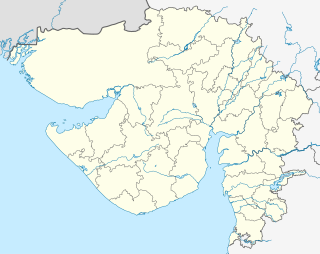
Ambaji (Ambājī) is a census town in Banaskantha district in the state of Gujarat, India. It is known for its historical and mythological connections with sites of cultural heritage.

Kudargarh is a famous Hindu pilgrim centre situated in Surajpur District of the state of Chhattisgarh in India. It is 40 km from district headquarters of Surajpur connected by an all-weather road. The best time to visit is during Chaitra Navaratra . It is located on a hillock with approximately 800 steps. A very panoramic view from top on addition to the DARSHAN of deity.
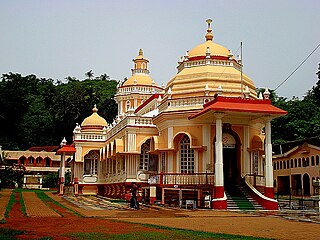
Kula-dèvatā, also known as Kuladeva or Kuladevi is an ancestral tutelary deity in Hinduism, who is often the object of one's devotion (bhakti) inorder to coax the god for favours, and to have the god the watch over one's family and children from probable misfortune. This is distinct from Ishta-devata and village deities.

Chintpurni is a major pilgrimage Centre and one of the Shakti Peethas in India. The Chintpurni shakti peeth is located in Una district Himachal Pradesh state, surrounded by the western Himalayas in the north and east in the smaller Shiwalik range bordering the state of Punjab. The Chintpurni Shakti Peeth houses the temple of Chinnamastika Devi or Chinnamasta Devi. Chhinnamasta or Chinnamastika temple is one of the 7 major and 51 total Shakti Peethas. Here, Chhinnamasta is interpreted as the severed-headed one as well as the foreheaded-one. The Hindu genealogy registers at Chintpurni, Himachal Pradesh are kept here.

Trilokpur is a Hindu temple site in Himachal Pradesh, India. It is located on an hillock about 24 km south-west of Nahan at an elevation of about 430 m. The temple is an amalgam of Indo-Persian styles of architecture.

Mata Mansa Devi is a Hindu temple dedicated to goddess Mansa Devi, a form of Shakti, in the Panchkula district of Haryana state in India. The temple complex is spread of 100 acres (0.40 km2) of the Shivalik foothills in the village of Bilaspur, near Sector 13 of Chandigarh, and Panchkula, 10 km from Chandi Mandir, another noted Devi shrine in the region, both just outside Chandigarh.

The Taratarini Temple on the Kumari hills at the bank of the River Rushikulya near Brahmapur city in Ganjam District, Odisha, India is worshiped as the Breast Shrine and manifestations of Adi Shakti. The Tara Tarini Shakti Peetha is one of the oldest pilgrimage centers of the Mother Goddess and is one of four major ancient Tantra Peetha and Shakti Peethas in India.
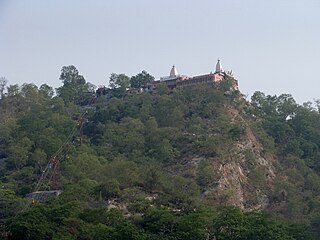
Mansa Devi Temple, Haridwar is a Hindu temple dedicated to goddess Mansa Devi in the holy city of Haridwar in the Uttarakhand state of India. The temple is located atop the Bilwa Parvat on the Sivalik Hills, the southernmost mountain chain of the Himalayas. The temple, also known as Bilwa Tirth is one of the Panch Tirth within Haridwar.

Maya Devi Temple, Haridwar is a Hindu temple dedicated to goddess Maya in the holy city of Haridwar of Uttarakhand state in India. It is believed that the heart and navel of goddess Sati fell in the region where the temple stands today and thus it is sometimes referred to as a Shakti Peetha.

Chandi Devi Temple, Haridwar is a Hindu temple dedicated to Goddess Chandi Devi in the holy city of Haridwar in the Uttarakhand state of India. The temple is situated atop the Neel Parvat on the Eastern summit of the Sivalik Hills, the southernmost mountain chain of the Himalayas. Chandi Devi Temple was built in 1929 by Suchat Singh in his reign as the King of Kashmir. However, the main murti of Chandi Devi at the temple is said to have been installed in the 8th century by Adi Shankaracharya, one of the greatest priests of Hindu religion. The temple also known as Neel Parvat Teerth is one of the Panch Tirth located within Haridwar.

Patan Devi, also called Maa Patneshwari, is the oldest and one of the most sacred temples of Patna. It is regarded as one of the 51 Siddha Shakti Pithas in India. According to Puranic legends, the 'right thigh' of the corpse of Devi Sati had fallen here when it was chopped off by Lord Vishnu with his 'Sudarshan Chakra'. The ancient temple, originally called Maa Sarvanand Kari Patneshwari, is believed to be the abode of the goddess Durga.

Belha Devi Temple is an old Hindu temple in the city of Bela Pratapgarh, dedicated to the goddess Belha, the local incarnation of the Devi.

Mata Mansa Devi is a Hindu temple dedicated to goddess Mansa Devi, a form of Shakti, in the Sikar district of Rajasthan state in India. The temple complex is spread of 100 acres (0.40 km2) of the Hasampur Hills foothills in village Hasampur, near Neem-Ka-Thana, and Sikar, 20 km from National Highway 8 (India) Kotputli, another noted Devi shrine in the region, both just outside Sikar.
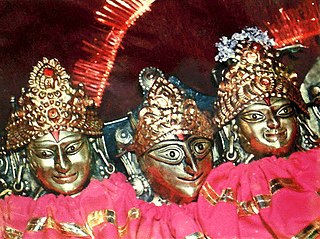
Shoolini, is the principle form of the Goddess Durga, also known as Devi and Shakti.



















